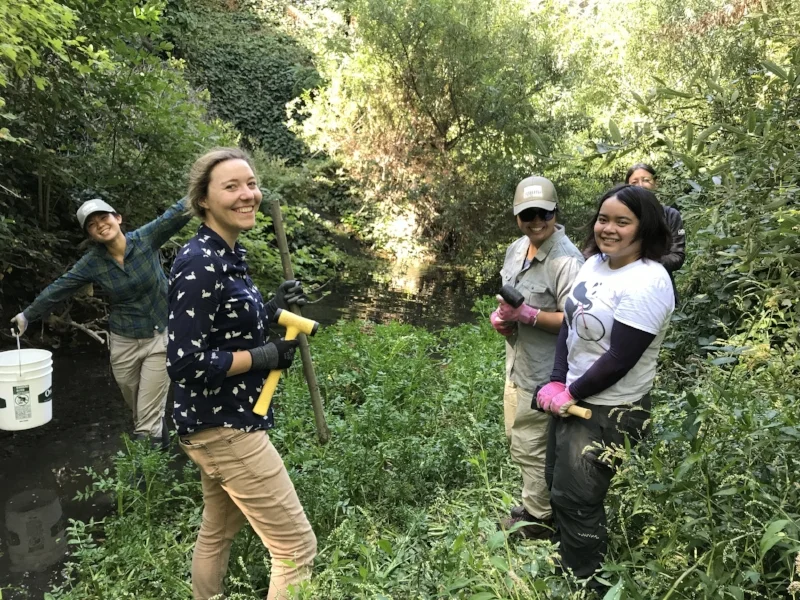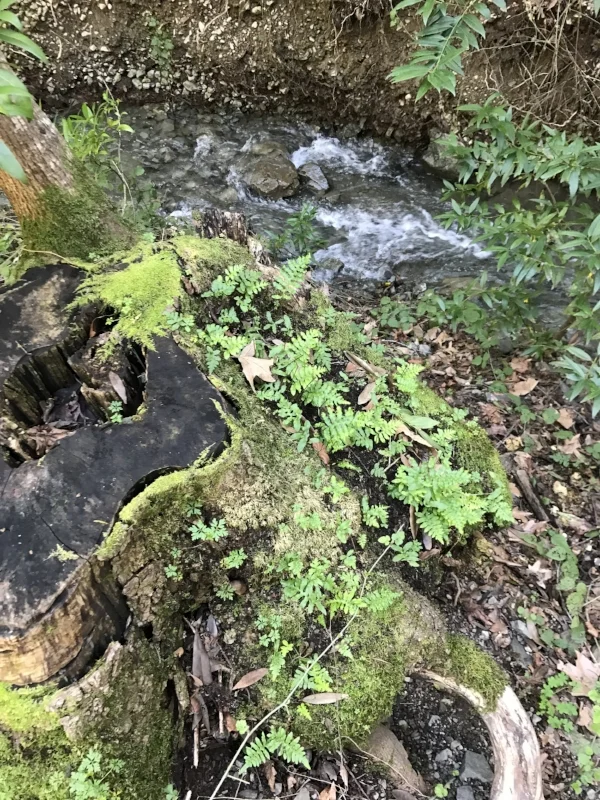Connecting Creeks to Climate Change
By Kathleen Tarlow, Education Manager
“What’s that?” asked a curious fourth grade student. We were standing on the bridge over San Francisquito Creek near El Palo Alto Park, where a class from a nearby Palo Alto elementary school had gathered to learn about the history of the park and then plant native plants along the path.
The student was pointing down to the dry creek bed below. I was initially surprised that the student didn’t recognize it for what it was. San Francisquito Creek is one of the more recognizable creeks in our area. Compared with other local creeks like Matadero, Adobe, or Redwood Creek that are almost entirely channelized in concrete, San Francisquito Creek still runs freely for much of its course and has a narrow corridor of intact riparian habitat.
Similar to many of our local creeks, parts of Matadero Creek in Palo Alto have been channelized
The student didn’t recognize the creek partly because it was dry, which is true of many of our local creeks in the arid months of summer and fall. But it’s also easy to overlook our local waterways because so many of them have been made all but invisible—hidden under roads, inside pipes and channels. Humans have shaped waterways for convenience, and in the process we have eliminated riparian habitat—the zone where land and a stream or river intersect—which provides valuable ecosystem services.
Healthy riparian habitat has many documented benefits. On a healthy creek, vegetation along stream banks takes up excess nutrients and traps sediment, improving water quality. The diverse plant life supports a rich food web, creating areas of high biodiversity. Intact riparian habitat also helps reduce flooding, acting as a buffer during surging storm waters. But we eliminate these kinds of benefits when we build dams and levees or constrict our creeks into concrete channels.
A recent study points to an important benefit of riparian forests. Point Blue Conservation Science and Santa Clara University analyzed existing scientific publications on riparian forest habitat (click here for a link to the full article) and found an additional benefit in the ability of riparian forests to sequester carbon. While tropical and boreal forests are often what we think of as the globe’s massive forest carbon sinks, the paper suggests that riparian forests have a comparable ability to store carbon. Furthermore, the study found that promoting riparian reforestation through restoration activities can jump-start the carbon sequestration process. This is in addition to known benefits of riparian forest restoration like improving water quality, enhancing wildlife habitat, and improving recreational activities like fishing and bird watching that increase community engagement with nature.
At Grassroots Ecology, we have a number of projects aiming to protect and restore riparian habitat. We plant willows along San Francisquito Creek, along with native plantings higher up the bank that were installed with the help of local fourth graders. These willows provide habitat for creek-loving creatures, and also help hold soil in place and trap sediment during the rainy season as surface water rushes to the bay. At Redwood Grove, we are helping steward redwood trees along Adobe Creek that have been part of that ecosystem for the last hundred years.
Grassroots Ecology staff team up to do willow staking along San Francisquito Creek
One of our oldest projects was the daylighting (or opening up) of a creek out of a concrete culvert at Arastradero Preserve. Mayfly Creek—an ephemeral tributary to Matadero Creek—now runs free, winding through the valley. With our volunteers’ help, we have planted and maintained thousands of native plants to create a rich and diverse environment that slows, spreads, and drains the water up in the foothills to help reduce downstream flooding.
Hendrys Creek, one of our riparian restoration sites
One of our most active riparian restoration sites right now is at Hendrys Creek, east of Lexington Reservoir in Los Gatos. This 117-acre property was acquired by the Midpeninsula Regional Open Space District, and Grassroots Ecology has been helping restore a healthy, forested riparian habitat along the creek. Working with the San Jose Conservation Corps, the team has removed invasive French broom, vinca, and Himalayan blackberry, and is replacing them with native grasses, shrubs, and trees. Together we planted hundreds of canyon live and coast live oak acorns and California buckeye nuts to try to jump-start a new generation of trees that will join existing big leaf maple, white alders, sycamores, oaks, and bays already at the site.
Though riparian forest is difficult to come by in this busy hub of Silicon Valley, the Point Blue study is a reminder of all the ecosystem services natural areas provide for us, and the importance of protecting them and keeping them healthy. So, let’s ask not just what our creeks do for us, but what we can do for our creeks! Join us at a creek planting, water quality monitoring event, or just go find your local creek and get involved in its stewardship!




